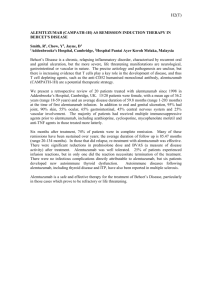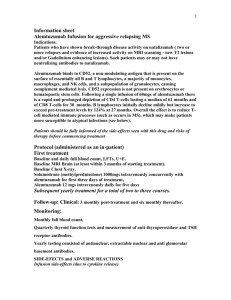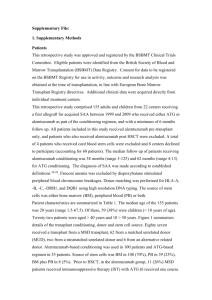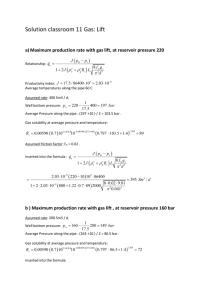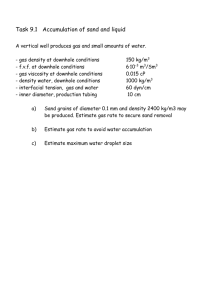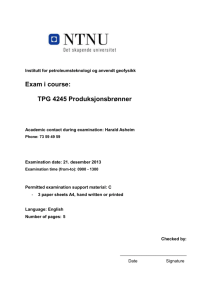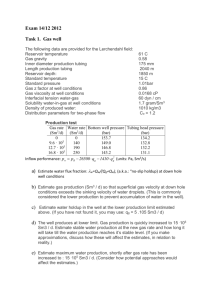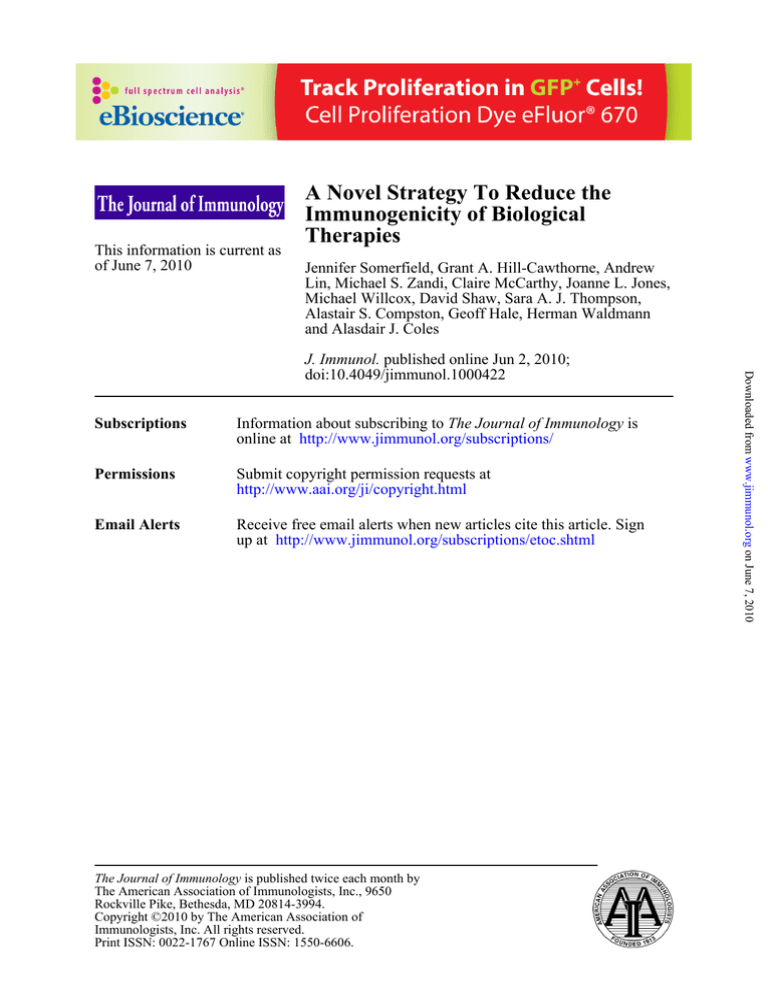
This information is current as
of June 7, 2010
A Novel Strategy To Reduce the
Immunogenicity of Biological
Therapies
Jennifer Somerfield, Grant A. Hill-Cawthorne, Andrew
Lin, Michael S. Zandi, Claire McCarthy, Joanne L. Jones,
Michael Willcox, David Shaw, Sara A. J. Thompson,
Alastair S. Compston, Geoff Hale, Herman Waldmann
and Alasdair J. Coles
Subscriptions
Information about subscribing to The Journal of Immunology is
online at http://www.jimmunol.org/subscriptions/
Permissions
Submit copyright permission requests at
http://www.aai.org/ji/copyright.html
Email Alerts
Receive free email alerts when new articles cite this article. Sign
up at http://www.jimmunol.org/subscriptions/etoc.shtml
The Journal of Immunology is published twice each month by
The American Association of Immunologists, Inc., 9650
Rockville Pike, Bethesda, MD 20814-3994.
Copyright ©2010 by The American Association of
Immunologists, Inc. All rights reserved.
Print ISSN: 0022-1767 Online ISSN: 1550-6606.
Downloaded from www.jimmunol.org on June 7, 2010
J. Immunol. published online Jun 2, 2010;
doi:10.4049/jimmunol.1000422
Published June 2, 2010, doi:10.4049/jimmunol.1000422
The Journal of Immunology
A Novel Strategy To Reduce the Immunogenicity of
Biological Therapies
Jennifer Somerfield,* Grant A. Hill-Cawthorne,† Andrew Lin,† Michael S. Zandi,†
Claire McCarthy,† Joanne L. Jones,† Michael Willcox,‡ David Shaw,‡ Sara A. J. Thompson,†
Alastair S. Compston,† Geoff Hale,‡ Herman Waldmann,x,1 and Alasdair J. Coles†,1
B
iological therapies induce Ab responses that may neutralize
efficacy and reduce long-term usefulness, for instance,
IFN-a treatment of hepatitis C (1), animal insulin for
diabetes mellitus (2), human growth hormone for short stature
(3), factor VIII in hemophilia (4), and IFN-b treatment of
multiple sclerosis (5, 6).
The first therapeutic rat mAbs briskly induced antiglobulin
responses in humans (7). Attempts to circumvent this problem included replacing much of the murine Ab with a human Ig framework, creating first “chimeric” and then “humanized” Ags.
Alemtuzumab (Campath-1H) was the first therapeutic humanized
Ab, in which only the complementarity-determining regions were
retained from the original murine Ab, Campath-1G (8); binding to
CD52, it targets human B and T lymphocytes, eosinophils, and
monocytes (9) and induces long-lasting lymphopenia (10, 11). However, these unique idiotypic residues may still induce an antiglobulin
response, particularly if, like alemtuzumab, they target Ags on the
surface of hematopoietic cells (12). In a single-dose escalation study
of alemtuzumab treatment of rheumatoid arthritis, 63% of patients
developed antiglobulin responses with an observed reduction in
*Department of Medicine, University of Auckland, Auckland, New Zealand;
†
Department of Clinical Neurosciences, University of Cambridge, Cambridge;
‡
BioAnaLab; and xSir William Dunn School of Pathology, University of Oxford,
Oxford, United Kingdom
1
H.W. and A.J.C. are cosenior authors.
Received for publication February 5, 2010. Accepted for publication April 29, 2010.
This work was supported by the Moulton Charitable Foundation. SM3 was provided
by the Therapeutic Antibody Centre, Oxford and derived from work supported by
a Medical Research Council Programme Grant (to H.W.). A.J.C. is funded in part by
the National Institute for Health Research (NIHR) Biomedical Research Centre,
Cambridge. D.A.S.C. is an NIHR senior investigator. J.S. was funded by the Multiple
Sclerosis International Federation and the Neurological Foundation of New Zealand.
Address correspondence and reprint requests to Dr Alasdair J. Coles, Department
of Clinical Neurosciences, Box 165, Addenbrooke’s Hospital, Cambridge CB2 0QQ,
U.K. E-mail address: ajc1020@medschl.cam.ac.uk
Abbreviations used in this paper: ITP, idiopathic thrombocytopenic purpura; MRI,
magnetic resonance imaging.
Copyright Ó 2010 by The American Association of Immunologists, Inc. 0022-1767/10/$16.00
www.jimmunol.org/cgi/doi/10.4049/jimmunol.1000422
efficacy (13). In a phase 2 study in patients with early relapsing–
remitting multiple sclerosis, alemtuzumab was given as annual
cycles. Most patients’ antiglobulin responses had resolved prior to
the second and third exposures. We have already reported that only 1
of 208 (0.5%) and 51 of 194 patients (26.3%) had significant alemtuzumab-binding Abs (above a prespecified threshold of 2000 U/ml)
at months 12 and 24 (14). There was no indication, from these
limited data, that the presence of alemtuzumab-binding Abs influenced efficacy, infusion-associated reactions, lymphocyte depletion,
or repopulation. However, we anticipate that antiglobulin responses
might be more prolonged after repeated subsequent alemtuzumab
infusions and might therefore impact on the Abs efficacy.
Various strategies have been proposed that aim to reduce the
immunogenicity of biological therapies. We sought to investigate
whether long-lasting tolerance to a mAb could be induced by emulating classical experimental studies showing that high doses of
soluble protein may induce “high-zone” tolerance (15) and that
soluble monomeric IgG can tolerize mice to aggregated Ig (16).
However, at the doses required to test this effect, most cytotoxic
Abs would induce unacceptable adverse effects. For instance, even
low doses of alemtuzumab may cause an infusion reaction
consisting of pyrexia, tachycardia, and bronchospasm due to the
release of cytokines including IFN-g and IL-6 (17). Furthermore
the “danger signal” of cytolysis is likely to undermine induction of
tolerance. Therefore, a noncell-binding variant of alemtuzumab
was constructed that could be given at a high dose. Point mutations were made in the H2 loop of the H chain, which has been
shown to be critical for Ag binding (18, 19). Variant SM3, with
a charge reversal (Lys53 to Asp53), was found in experimental
animals to abrogate binding activity so that it could be given in
high doses. This was nonimmunogenic and induced long-lasting
tolerance to subsequent cycles of alemtuzumab in mice expressing
a human CD52 transgene (19).
For the first time in humans, we tested the strategy of tolerizing to
a biological therapy by pretreatment with a high dose of a noncellbinding variant. Our principal outcome measure was the incidence of
anti-alemtuzumab Abs after a second cycle of alemtuzumab. We also
tested whether this strategy interfered with the efficacy of
Downloaded from www.jimmunol.org on June 7, 2010
Biological therapies, even humanized mAbs, may induce antiglobulin responses that impair efficacy. We tested a novel strategy to
induce tolerance to a therapeutic mAb. Twenty patients with relapsing–remitting multiple sclerosis received an initial cycle of
alemtuzumab (Campath-1H), up to 120 mg over 5 d, preceded by 500 mg SM3. This Ab differs from alemtuzumab by a single
point mutation and is designed not to bind to cells. Twelve months later, they received a second cycle of alemtuzumab, up to 72 mg
over 3 d. One month after that, 4 of 19 (21%) patients had detectable serum anti-alemtuzumab Abs compared with 145 of 197
(74%) patients who received two cycles of alemtuzumab without SM3 in the phase 2 CAMMS223 trial (p , 0.001). The efficacy
and safety profile of alemtuzumab was unaffected by SM3 pretreatment. Long-lasting “high-zone” tolerance to a biological
therapy may be induced by pretreatment with a high i.v. dose of a drug variant, altered to reduce target-binding. The
Journal of Immunology, 2010, 185: 000–000.
2
REDUCING THE IMMUNOGENICITY OF BIOLOGICAL THERAPIES
alemtuzumab on clinical and magnetic resonance imaging (MRI)
outcomes, comparing with results from the previously reported
CAMMS223 trial.
Materials and Methods
Patients
Twenty patients were recruited for this pilot study from August 2005 to July
2007. We included male or nonpregnant and nonlactating female patients
with relapsing–remitting multiple sclerosis, Expanded Disability Status
Scale (EDSS) score 0–6.0 (inclusive) at screening visit, at least three
clinical episodes in the 2 y prior to study entry, and MRI brain scan
compatible with the diagnosis of multiple sclerosis, who met McDonald
criteria for the diagnosis of multiple sclerosis (20). Key exclusion criteria
were progressive multiple sclerosis, prior alemtuzumab treatment, prior
immunotherapy (except for pulsed corticosteroids and IFN-b), and the
presence of a malignancy or major systemic and autoimmune disease.
Patients taking IFN-b stopped that treatment at least 1 mo before study
entry. All of the patients provided written informed consent (EUDRACT
2005-002305-23, CTA 12854/0008/001, and REC 05/Q0501/64). Control
data for the primary outcome measure came from the 216 patients who
received two doses of alemtuzumab in the CAMMS223 trial (108 each
receiving the 12 or 24 mg/d doses), of which samples were available from
212 at month 1 and from 197 at month 13 (14).
On day 1, 50 mg SM3 was administered by i.v. infusion, and patients were
observed for the next 24 h for adverse effects. The following day, 450 mg
was given over 4 h. The first dose of alemtuzumab was administered on day
8. Alemtuzumab was administered by daily i.v. infusion. For the first two
patients, 120 mg was given over five consecutive days (24 mg/d on days 8–
12 of the study), and at month 12, these patients were treated with 72 mg
alemtuzumab alone over three consecutive days (24 mg/d). After a fatal
case of idiopathic thrombocytopenic purpura (ITP) occurred in the phase 2
alemtuzumab trial (CAMMS223) in June 2005, dosing in this trial was
temporarily suspended and then restarted (for the remaining 18 patients) at
a reduced dose of 60 mg over five consecutive days (12 mg/d on days 8–12
of the study) and 36 mg over three consecutive days (12 mg/d) at month 12
(14). Data from the CAMMS223 trial suggest that these doses are equally
immunogenic. All of the patients received 1 g methylprednisolone i.v.
immediately before the first three doses of alemtuzumab to ameliorate the
cytokine release syndrome (17). Additional medications to manage infusion-associated reactions, such as antihistamines and antipyretic agents,
were used as required.
Statistical analysis
The primary outcome measure was the proportion of patients with detectable
binding anti-alemtuzumab Abs in serum at 1 mo after the second alemtuzumab cycle, compared using a two-tailed Fisher’s exact test to the same time
point in patients receiving alemtuzumab alone in the CAMMS223 trial.
Differences in the mean concentration of serum anti-alemtuzumab Abs at
both time points were assessed by an unpaired two-tailed Student t test.
Clinical assessments
Results
Patients were monitored in hospital during treatment with SM3 and
alemtuzumab. Follow-up was at 1 mo after discharge then every 3 mo for
a minimum of 24 mo with monitoring of thyroid function, blood count, and
lymphocyte phenotypes. After a risk management plan for ITP was adopted
within the CAMMS223 trial (14), similar procedures were put in place in
this trial, including monitoring monthly platelet counts for 3 y after each
alemtuzumab infusion. An unblinded treating physician was responsible
for patient care, the management of adverse events, and reviewing of
laboratory data. Disability, as determined by the EDSS (21), was assessed
by a blinded neurologist. A relapse was defined as new neurologic symptoms attributed to multiple sclerosis, lasting .48 h with an objective
change in the neurologic examination. In a subset of patients, monthly
gadolinium-enhanced T1 and T2 MRI scans were performed.
Twenty patients (Table I) with relapsing–remitting multiple sclerosis
were recruited to the study, of whom 11 were treatment naive, 8 had
received IFN-b, and 1 had previously had plasma exchange. All met
criteria for disease activity irrespective of treatment status. Twenty
patients received SM3 on days 1–2 followed by alemtuzumab,
consisting of daily infusions on days 8–12. One patient withdrew
from the trial due to perceived lack of efficacy; the remaining 19
underwent a second cycle of alemtuzumab at month 12 (3 d of daily
infusions).
Other assessments
Serum was assayed for alemtuzumab-binding Abs using a validated bridging
ELISA performed by BioAnaLab, which has a lower threshold for detection
of 444 ng/ml of a monoclonal anti-alemtuzumab reference standard (22).
Additional assays for alemtuzumab-binding Ab isotypes were developed inhouse. Anti-alemtuzumab IgG titers were assessed by ELISA. Microlon
high binding ELISA plates (Greiner Bio One, Paris, France) were coated
with 10 mg/ml rat Ab, Campath-1G, in PBS plus 0.05% sodium azide overnight at 4˚C. Plates were blocked with 2% albumin BSA (A1470; SigmaAldrich, St. Louis, MO) in PBS for 2 h before being washed four times in
PBS plus 0.05% Tween 20 (P1379; Sigma-Aldrich). Test serum samples
were added to the plates at 50 ml per well in a dilution of 1:2 in PBS.
Samples were incubated for 1 h at 20˚C. The plates were washed as above
between each step and followed sequentially by 2.5 mg/ml biotinylated
mouse anti-human IgG clone 8a4 (Immunotech, Luminy, France) and
Pharmacokinetics of SM3
The pharmacokinetic profile of SM3 was estimated from measurements of SM3 concentrations between day 6 and day 363 in 104
Table I. Baseline characteristics of patients
Demographics
Age at disease onset (y)
n
20
Mean (6SD)
32 (7.04)
Range
16–44
Percentage female (no.) 65 (13)
Baseline disability
Mean EDSS (6SD) 3.1 (1.57)
Range
0–6
Time since first episode (mo)
Mean (6SD)
43 (32)
Range
14–133
Prior drug therapy
No (%)
9 (45)
Downloaded from www.jimmunol.org on June 7, 2010
Procedures
1:2000 extravidin–peroxidase (E2886; Sigma-Aldrich) in PBS, each incubated for 1 h at 20˚C. Bound enzyme was detected by the addition of ophenylenediamine (P8287; Sigma-Aldrich), and absorbance was read at 450
nm on a kinetic protocol with readings every 60 s for 20 min using a Bio-Rad
680 Microplate Reader (Hercules, CA). Readings were displayed using BioRad Microplate Manager 5.2 software as maximum velocity of absorbance
(mOD/min), because no standard exists for anti-alemtuzumab IgG.
A similar protocol was used for the anti-alemtuzumab IgM assay with the
following differences. Microlon plates were coated with 8 mg/ml anti-IgM
Ab (ab36088; AbCam, Cambridge, MA) in 15 mM Na2CO3 and 35 mM
NaHCO3 overnight at 4˚C. Blocking buffer was 0.5% casein (C4765;
Sigma-Aldrich) in PBS with a 1 h incubation. Detecting Ab was 2
mg/ml biotinylated Campath-1H in PBS followed by 1:2000 extravidin–
peroxidase in PBS. Bound enzyme was detected using tetramethylbenzidine substrate (T0440; Sigma-Aldrich), the reaction being stopped with 2
M H2SO4 after 20 min. Absorbance was read at 450 nm on an end point
protocol. No standard could be used; therefore, samples and controls were
run on the same plate, allowing comparative ODs to be recorded. For both
assays, a negative control (serum from a healthy control) and a positive
control (serum from N.C., a patient who had received multiple alemtuzumab infusions for a non-multiple-sclerosis indication) were used.
Concentrations of SM3 in patient sera were measured by sandwich
immunoassay using a Gyrolab (Upsalla, Sweden) xP instrument. Biotinlabeled rat anti-Campath idiotype mAb (YID13.9) was captured to a Gyrolab Bioaffy 200 disc at a concentration of 74 mg/ml in Gyrolab Rexxip A
assay diluent. Test samples and SM3 calibrators over the concentration
range of 39–50,000 ng/ml prepared in normal serum were diluted to 10%
with Gyrolab Rexxip H assay diluent and applied to the affinity matrix.
Binding of SM3 was detected with an Alexa Fluor 647-labeled goat antihuman IgG1 Ab at a concentration of 3 nM. Fluorescence output was
measured at a photomultiplier setting of 1%, and the concentration of
SM3 was determined by interpolation on the standard curve.
ELISAs were performed to quantify levels of IFN-g, TNF-a, and IL6
(DuoSet DY285, DY210, and DY206, respectively; R&D Systems,
Minneapolis, MN) on serum samples from patients at baseline, 2, 4, and
6 h after SM3 infusion on days 1 and 2 and at baseline on day 3 according
to the manufacturer’s instructions.
The Journal of Immunology
3
compared with SM3. The measured concentrations fitted a single
exponential curve with a half-life of 32.1 d and an estimated
concentration at time 0 of 58.0 mg/ml, corresponding to a volume
of distribution of ∼8.6 L. The estimated mean concentration of
SM3 at 1 mo was 30.3 mg/ml and at 13 mo was 0.01 mg/ml.
Efficacy of SM3 as tolerogen for alemtuzumab
FIGURE 1. Pharmacokinetics of SM3. Concentrations of SM3 were
measured by sandwich immunoassay in a Gyrolab instrument. Samples were
analyzed at irregular times between 6 and 363 d from 18 patients. The logtransformed concentrations were fitted to a straight line by linear regression.
samples from 18 of the 20 patients (Fig. 1). The assay relied on the
capture of SM3 to an anti-idiotype Ab raised against alemtuzumab
and therefore was able to detect both SM3 and alemtuzumab
equally well. For the purpose of this preliminary pharmokinetic
analysis, the contribution of alemtuzumab to the measured concentrations was ignored because the dose was so relatively small
FIGURE 2. Efficacy outcome measures. A, Percentage of patients receiving
SM3 (+SM3) that had detectable (.444
U/ml) anti-alemtuzumab Abs at month 1
and month 13 (1 mo after first and second alemtuzumab treatments, respectively) compared with patients in the
CAMMS223 trial (2SM3) who were
on either 12 or 24 mg/d doses of alemtuzumab (with pooled data charted as
well). B, Mean anti-alemtuzumab Ab
concentrations at month 1 and month
13 of SM3 patients (+SM3) and those
from the CAMMS223 trial (2SM3). Error bars indicate SDs. In both outcome
measures, there was a significant difference between the CAMMS223 and SM3
groups at both time points (pppp ,
0.0001). There was also a significant difference between the mean Ab concentrations at month 1 and month 13, within
both the CAMMS223 and the SM3
groups (p , 0.0001, not asterisked).
B
Downloaded from www.jimmunol.org on June 7, 2010
A
The primary outcome was met. The use of SM3 before the first dose of
alemtuzumab reduced the proportion of patients with detectable
(.444 U/ml) serum anti-alemtuzumab Abs after two cycles of alemtuzumab by 72% when compared with data from the CAMMS223
trial, using the same bridging ELISA run in a quasi-quantitative
format, using a reference monoclonal anti-alemtuzumab Ab as a calibrator to allow relative estimates of Ab concentrations (Fig. 2A, 74
versus 21%, p , 0.0001). There was no statistically significant difference in the proportion of patients developing anti-alemtuzumab
Abs in response to the two alemtuzumab doses (Fig. 2A).
Secondary outcome measures were also met. The mean concentration of detectable anti-alemtuzumab Abs at month 13 was .100fold lower in the SM3 group (mean 3640 U/ml) compared with the
CAMMS223 group (536,600 U/ml) (Fig. 2B, p , 0.0001). As
expected, there was a significant increase in both percentage of
4
REDUCING THE IMMUNOGENICITY OF BIOLOGICAL THERAPIES
A
FIGURE 3. Isotype of anti-alemtuzumab Abs.
ELISA measurement of (A) IgM and (B) IgG antialemtuzumab Abs in three representative patients treated with alemtuzumab alone (from the CAMMS223
trial) and the four patients from the SM3 trial who
developed anti-alemtuzumab Ab responses at month
13. Units are based on the OD of the ELISAs.
B
lymphocytes after the first and second cycle of alemtuzumab were
equivalent to those seen in patients who did not receive SM3 pretreatment; for instance, at month 12, the mean CD4, CD8, and CD19
counts were 25.6, 36.8, and 128.7% of baseline. The on-study mean
annualized relapse rate was 0·08 (6SD), and the mean change in
disability over 24 mo was an improvement by 1–2 EDSS points;
both results are comparable to previous trials of alemtuzumab in
multiple sclerosis (10, 14). The mean numbers of new gadoliniumenhancing lesions formed on monthly MRI scans performed for 6
mo after the first and second alemtuzumab cycles were 0.38 and 0.5,
respectively, which is also comparable to that seen with previous
use of alemtuzumab (23, 24).
Safety and tolerability
Most (80%) patients experienced grade 1 infusion-associated reactions (Table II) associated with SM3 administration. These were
milder than those seen when 12 mg alemtuzumab was administered, with methylprednisolone premedication, in the phase 2 trial
of alemtuzumab (14). A total of 500 mg SM3 did reduce the total
lymphocyte count to 36% of baseline (range 19–53%) by day 8
(prior to alemtuzumab), and this was accompanied by a rise in Creactive protein up to 30 mg/ml by day 3. Eleven of 17 (65%)
patients had detectable serum IL-6, maximal 6 h after starting the
day 2 SM3 infusion. In 4 or 17 (24%) patients, there was
Downloaded from www.jimmunol.org on June 7, 2010
patients with detectable anti-alemtuzumab Abs and Ab concentration
between the first and second cycles of alemtuzumab within both
groups (all p , 0.0001). There was no statistically significant difference in the concentration of anti-alemtuzumab Abs between the two
alemtuzumab doses (Fig. 2B).
No anti-alemtuzumab Abs could be detected in the SM3 group at
1 mo after the first cycle of alemtuzumab; a significant reduction
compared with the CAMMS223 group (p = 0.0024). However,
considering the high concentration of SM3 still present at this
time (30.3 mg/ml), it is likely that anti-alemtuzumab Abs could
not have been detected because they would have been bound to the
SM3 and most likely cleared from circulation.
We devised isotype-specific anti-alemtuzumab ELISAs to determine whether the antiglobulin responses seen in four SM3 patients
were primary or secondary. No anti-alemtuzumab IgM was
detected at month 1 or 13 (Fig. 3A). However, low levels of
anti-alemtuzumab IgG were detected at month 1, which increased
significantly by month 13 (Fig. 3B).
Out of the four patients who developed Abs to alemtuzumab at
month 13, one had received IFN-b1a before taking part in this trial;
one had had plasma exchange; and two were immunotherapy-naive.
There was no indication that SM3 pretreatment interfered with the
efficacy of alemtuzumab either to deplete its target cells or to reduce
disease activity in multiple sclerosis. Depletion and reconstitution of
The Journal of Immunology
5
Table II. Adverse events in the SM3 trial versus the CAMMS223 trial
CAMMS223
(%)
2 (10)
23.1
16 (80)
0
98.6
1.4
15 (75)
9 (45)
8 (40)
2 (10)
1 (5)
1 (0.5)
37.5
17.1
59.3
27.8
9.7
13
19 (95)
0 (0)
65.7
4.2
10 (50)
1 (5)
4 (20)
1 (5)
2 (10)
1 (5)
1 (5)
1 (5)
1 (5)
47.7
11.6
5.6
,5
,5
,5
,5
,5
,5
1 (5)
1 (5)
,5
,5
1 (5)
2 (10)
0
23
2 (10)
1 (5)
1 (5)
1 (5)
1 (5)
1 (5)
1 (5)
1 (5)
1 (5)
30.6
,10
11.1
,10
26.9
24.5
,10
,10
0
detectable serum TNF-a, but serum IFN-g was undetectable
throughout. Overall, the cytokine release was substantially less
than that seen in studies of alemtuzumab administered alone (17).
There were two serious adverse events. One patient developed
autoimmune hemolytic anemia at 19 mo. She was symptomatic for
a few days but responded rapidly to oral corticosteroids, requiring
treatment for 4 mo but now well off medication for 6 mo to date. A
second patient developed Castleman’s disease 31 mo after the first
cycle of alemtuzumab. She presented with fever, abdominal pain,
and lymphadenopathy, a lymph node biopsy showing polyclonal expansion of the TCR and B cell Ig. Tests were negative for HIV and
human herpes virus 8. She received treatment with chemotherapy
with cyclophosphamide, hydroxydaunorubicin (doxorubicin), Oncovin
(vincristine), prednisone/prednisolone, and rituximab and has been
in remission for over 12 mo to date.
Discussion
We show for the first time in humans and in agreement with animal
data (19) that immunogenic cell-binding Abs can be rendered tolerogenic by changing residues essential for Ag binding. Specifically, SM3 is identical to alemtuzumab in a monomeric form except
for a single mutation, which significantly reduces its binding to the
target Ag, CD52. We calculated that the t1/2 of SM3 is 32.1 d. This
is a little longer than that derived from the classical study of IgG1 in
humans (mean 21 d from six individuals, range 15–30 d) (25) and
Acknowledgments
SM3 was provided by the Therapeutic Antibody Centre, Oxford, U.K., and
alemtuzumab was supplied by Genzyme. Clinical work was performed in
the Wellcome Trust Clinical Research Facility, Cambridge University Hospitals, National Health Service Foundation Trust.
Downloaded from www.jimmunol.org on June 7, 2010
Adverse events
Serious adverse events
Infusion-associated reactions
Any event
Serious adverse event
Events
Pyrexia
Chills
Headache
Fatigue
Musculoskeletal discomfort
Dyspnoea
Infectious adverse events
Any event
Serious adverse event
Infection-associated event
Upper respiratory tract infection
Urinary tract infection
Varicella
Oral candidiasis
Gastroenteritis
Sinusitis
Fungal skin infection
Gum infection
Nonspecific viral illness with
Vomiting
Otitis externa
Tooth abscess
Autoimmune-associated events
Hemolytic anemia
Thyroid-associated events
Other events
Fatigue
Seizure
Pyrexia
Flare of asthma
Headache
Skin rash
Carpel tunnel
Breast fibroadenoma
Castleman’s disease
SM3 n
(%)
significantly longer than that of alemtuzumab, which shows an
initial rapid clearance that depends on the lymphocyte load and
a terminal t1/2 between 7 and 21 d (26). This may suggest that
alemtuzumab is cleared in part through binding to CD52. Infusion
of high-dose SM3 reduced the percentage of patients with a detectable antiglobulin response to a second cycle of alemtuzumab administered 12 mo later from 74–21% (p , 0.0001); furthermore,
the concentration of anti-alemtuzumab Abs at this time point was
reduced .300-fold (p , 0.0001). We do not yet know how long this
tolerance, partial for some patients and complete for most, will
persist; responses to any future alemtuzumab administration will
clarify this. Nonetheless, this proof of concept suggests one strategy
for the prevention of antiglobulins against biological therapies
intended to be given long term. In this small cohort, SM3 has not
interfered with the efficacy of alemtuzumab as a treatment for
treating multiple sclerosis over 2 y.
The strategy for reducing the immunogenicity of alemtuzumab in
this study depends on two immune mechanisms: high-zone tolerance
and the reduction of danger signals. High-zone tolerance was first
demonstrated by s.c. injection of very high doses of BSA; subsequent
Ag re-exposure with adjuvant did not result in an immune response
(15). In the “Bonn protocol,” high doses of factor VIII treatment
induce tolerance in 87% of patients with hemophilia A who have
already developed Abs to factor VIII (27), perhaps by inducing
CD4+CD25+ regulatory T cells in peripheral lymphoid organs
(28). Other postulated mechanisms for high-zone tolerance are inhibition of B cell Ag presentation (29) or cathepsin-induced apoptosis of T cells (30). Inflammatory mediators or “danger signal”
may provoke immunogenicity (28), so, for instance, concomitant
infection reduces the efficacy of the Bonn protocol (31). Drugs,
such as alemtuzumab, that lyse hematopoietic cells, appear to create adjuvanticity for themselves and are consequently particularly
immunogenic (12). Although SM3 was designed to be “nonbinding,” it did partially deplete lymphocytes and induce some cytokine
release, so there was limited danger signal at the time that alemtuzumab was subsequently given. In retrospect, this limited cell binding was evident in the original animal experiments on SM3 (19).
This may explain why anti-alemtuzumab Abs were generated in
four of the SM3 patients in response to the second cycle of alemtuzumab. Isotype studies suggested that this was a secondary IgG
response, implying that the patients had initiated a primary response against the first cycle but below the sensitivity of our assays.
Perhaps a completely nonbinding variant of alemtuzumab would be
yet more successful in inducing tolerance.
Overall, the number of adverse events appeared consistent with
prior use of alemtuzumab alone. We observed two serious adverse
events in this study, neither of which has been previously reported
after alemtuzumab. However, the autoimmune hemolytic anemia
seen here is congruent with a range of Ab-mediated autoimmune
diseases seen after alemtuzumab, especially thyroid disease and
rarely ITP (14). Castleman’s disease is a rare lymphoproliferative
disorder normally caused by human herpes virus 8.
This study has shown that high doses of a monomeric, nonbinding mAb minimize immunogenicity to subsequent exposure of
the therapeutic analogue. Larger studies are necessary to confirm
the efficacy and safety of this approach, which has the potential to
be applied to many biological therapies where immunogenicity
impacts on long-term efficacy.
6
REDUCING THE IMMUNOGENICITY OF BIOLOGICAL THERAPIES
Disclosures
A.J.C. has received consulting fees, lecture fees, and grant support from
Genzyme. A.S.C. has received consulting fees, lecture fees, and grant
support from Genzyme and lecture fees from Bayer Schering Pharma on
behalf of himself and the University of Cambridge. J.L.J. has received
consulting fees and lecture fees from Bayer Schering Pharma. H.W. is
an inventor of alemtuzumab Abs and is entitled to royalties on sales of
the product. All of the royalties received are donated to scientific research
funds. G.H. also receives royalties on sales of alemtuzumab and donates
them to charity.
14.
15.
16.
17.
18.
References
19.
20.
21.
22.
23.
24.
25.
26.
27.
28.
29.
30.
31.
Downloaded from www.jimmunol.org on June 7, 2010
1. Leroy, V., M. Baud, C. de Traversay, M. Maynard-Muet, P. Lebon, and
J. P. Zarski. 1998. Role of anti-interferon antibodies in breakthrough occurrence
during alpha 2a and 2b therapy in patients with chronic hepatitis C. J. Hepatol.
28: 375–381.
2. Prout, T. E. 1962. The antigenicity of insulin: a review. J. Chronic Dis. 15: 879–
885.
3. Moore, W. V., and and P. Leppert. 1980. Role of aggregated human growth
hormone (hGH) in development of antibodies to hGH. J. Clin. Endocrinol.
Metab. 51: 691–697.
4. Lusher, J. M. 2000. Hemophilia treatment. Factor VIII inhibitors with
recombinant products: prospective clinical trials. Haematologica 85(10, Suppl.):
2–5, discussion 5–6.
5. Goodin, D. S., E. M. Frohman, B. Hurwitz, P. W. O’Connor, J. J. Oger,
A. T. Reder, and J. C. Stevens. 2007. Neutralizing antibodies to interferon beta:
assessment of their clinical and radiographic impact: an evidence report: report
of the Therapeutics and Technology Assessment Subcommittee of the American
Academy of Neurology. Neurology 68: 977–984.
6. Hemmer, B., O. Stüve, B. Kieseier, H. Schellekens, and H. P. Hartung. 2005.
Immune response to immunotherapy: the role of neutralising antibodies to interferon beta in the treatment of multiple sclerosis. Lancet Neurol. 4: 403–412.
7. Waldmann, H. 2002. Reprogramming the immune system. Immunol. Rev. 185:
227–235.
8. Riechmann, L., M. Clark, H. Waldmann, and G. Winter. 1988. Reshaping human
antibodies for therapy. Nature 332: 323–327.
9. Waldmann, H., and and G. Hale. 2005. CAMPATH: from concept to clinic.
Philos. Trans. R. Soc. Lond. B Biol. Sci. 360: 1707–1711.
10. Coles, A. J., A. Cox, E. Le Page, J. Jones, S. A. Trip, J. Deans, S. Seaman,
D. H. Miller, G. Hale, H. Waldmann, and D. A. Compston. 2006. The window of
therapeutic opportunity in multiple sclerosis: evidence from monoclonal antibody therapy. J. Neurol. 253: 98–108.
11. Isaacs, J. D., S. Greer, S. Sharma, D. Symmons, M. Smith, J. Johnston,
H. Waldmann, G. Hale, and B. L. Hazleman. 2001. Morbidity and mortality in
rheumatoid arthritis patients with prolonged and profound therapy-induced lymphopenia. Arthritis Rheum. 44: 1998–2008.
12. Benjamin, R. J., S. P. Cobbold, M. R. Clark, and H. Waldmann. 1986. Tolerance
to rat monoclonal antibodies. Implications for serotherapy. J. Exp. Med. 163:
1539–1552.
13. Weinblatt, M. E., P. J. Maddison, K. J. Bulpitt, B. L. Hazleman, M. B. Urowitz,
R. D. Sturrock, J. S. Coblyn, A. L. Maier, W. R. Spreen, V. K. Manna, and
J. M. Johnston. 1995. CAMPATH-1H, a humanized monoclonal antibody, in
refractory rheumatoid arthritis. An intravenous dose-escalation study. Arthritis
Rheum. 38: 1589–1594.
Coles, A. J., D. A. Compston, K. W. Selmaj, S. L. Lake, S. Moran,
D. H. Margolin, K. Norris, and P. K. Tandon; CAMMS223 Trial Investigators.
2008. Alemtuzumab vs. interferon beta-1a in early multiple sclerosis. N. Engl. J.
Med. 359: 1786–1801.
Mitchison, N. A. 1964. Induction of immunological paralysis in two zones of
dosage. Proc. R. Soc. Lond. B Biol. Sci. 161: 275–292.
Weigle, W. O. 1973. Immunological unresponsiveness. Adv. Immunol. 16: 61–
122.
Moreau, T., A. Coles, M. Wing, J. Isaacs, G. Hale, H. Waldmann, and
A. Compston. 1996. Transient increase in symptoms associated with cytokine
release in patients with multiple sclerosis. Brain 119: 225–237.
Cheetham, G. M., G. Hale, H. Waldmann, and A. C. Bloomer. 1998. Crystal
structures of a rat anti-CD52 (CAMPATH-1) therapeutic antibody Fab fragment
and its humanized counterpart. J. Mol. Biol. 284: 85–99.
Gilliland, L. K., L. A. Walsh, M. R. Frewin, M. P. Wise, M. Tone, G. Hale,
D. Kioussis, and H. Waldmann. 1999. Elimination of the immunogenicity of
therapeutic antibodies. J. Immunol. 162: 3663–3671.
McDonald, W. I., A. Compston, G. Edan, D. Goodkin, H. P. Hartung,
F. D. Lublin, H. F. McFarland, D. W. Paty, C. H. Polman, S. C. Reingold, et al.
2001. Recommended diagnostic criteria for multiple sclerosis: guidelines from
the International Panel on the diagnosis of multiple sclerosis. Ann. Neurol. 50:
121–127.
Kurtzke, J. F. 1983. Rating neurologic impairment in multiple sclerosis: an expanded disability status scale (EDSS). Neurology 33: 1444–1452.
Cobbold, S. P., P. R. Rebello, H. F. Davies, P. J. Friend, and M. R. Clark. 1990. A
simple method for measuring patient anti-globulin responses against isotypic or
idiotypic determinants. J. Immunol. Methods 127: 19–24.
Coles, A. J., M. G. Wing, P. Molyneux, A. Paolillo, C. M. Davie, G. Hale,
D. Miller, H. Waldmann, and A. Compston. 1999. Monoclonal antibody treatment exposes three mechanisms underlying the clinical course of multiple
sclerosis. Ann. Neurol. 46: 296–304.
Moreau, T., J. Thorpe, D. Miller, I. Moseley, G. Hale, H. Waldmann, D. Clayton,
M. Wing, N. Scolding, and A. Compston. 1994. Preliminary evidence from
magnetic resonance imaging for reduction in disease activity after lymphocyte
depletion in multiple sclerosis. Lancet 344: 298–301.
Morell, A., W. D. Terry, and T. A. Waldmann. 1970. Metabolic properties of IgG
subclasses in man. J. Clin. Invest. 49: 673–680.
Elter, T., I. Molnar, J. Kuhlmann, M. Hallek, and C. Wendtner. 2008. Pharmacokinetics of alemtuzumab and the relevance in clinical practice. Leuk. Lymphoma 49: 2256–2262.
Brackmann, H. H., J. Oldenburg, and R. Schwaab. 1996. Immune tolerance for
the treatment of factor VIII inhibitors—twenty years’ ‘Bonn protocol’. Vox Sang.
70(Suppl. 1): 30–35.
Apostolou, I., and and H. von Boehmer. 2004. In vivo instruction of suppressor
commitment in naive T cells. J. Exp. Med. 199: 1401–1408.
Ashour, H. M., and and T. M. Seif. 2007. The role of B cells in the induction of
peripheral T cell tolerance. J. Leukoc. Biol. 82: 1033–1039.
Michallet, M. C., F. Saltel, M. Flacher, J. P. Revillard, and L. Genestier. 2004.
Cathepsin-dependent apoptosis triggered by supraoptimal activation of T lymphocytes: a possible mechanism of high dose tolerance. J. Immunol. 172: 5405–
5414.
Reipert, B. M., P. M. van Helden, H. P. Schwarz, and C. Hausl. 2007. Mechanisms of action of immune tolerance induction against factor VIII in patients
with congenital haemophilia A and factor VIII inhibitors. Br. J. Haematol. 136:
12–25.

